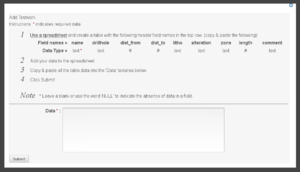Difference between revisions of "How to use the Litho table"
(Created page with "==The Litho database table== The 'Litho' table is used to partition other test results into groups. Those groups are commonly lithology (hence the table name), alteration, an...") |
(No difference)
|
Revision as of 19:01, 26 December 2012
Contents
The Litho database table
The 'Litho' table is used to partition other test results into groups. Those groups are commonly lithology (hence the table name), alteration, and zone. The Litho table also contains drill hole information, for those samples derived from drill holes, that allow geologists to relate the spatial positions of grindability samples within geological models.
The mandatory fields are:
- Sample: the sample name, and must be entered exactly as it appears in the other testwork tables in order for the grouping functions to work properly.
- Program: the sampling program that this sample belongs to. Must be entered exactly as it appears in the other testwork tables in order for the grouping functions to work properly.
The automatically generated fields are:
- #: the position in the current table. This value varies whenever the table sorting changes or when new data is entered.
- id: the unique row ID number of this database record.
- ProjNum: the project number that this record belongs to.
An optional comment field is available for assigning other information to a record. Examples of 'comment' information includes references to publications or drill hole dimensions (PQ, HQ).
Grouping of samples
Three special fields in the Litho table can be used for grouping samples. The names of these fields describe how they are typically used, but users are free to substitute other uses and are not restricted to entering the data described.
- litho is usually the dominant lithology of a sample. Examples are 'breccia', 'volcanic' or 'End member 1'.
- alteration is usually the dominate type of alteration of a sample. Examples are 'secondary enrichment', 'argillic' or 'quartz-sericite'.
- zone is usually a geographical or stratigraphic description of a sample. Examples are 'East zone', 'secondary enrichment' or 'main pit'.
In these examples, the term 'secondary enrichment' can go in any of the fields — how the fields are used should vary from deposit to deposit depending on what factors the geologists and metallurgists have determined are controlling the ore hardness and mineralization. The field names are only guidelines and the use of the fields can be tailored to suit a project's particular needs.
Drill hole identification
Four optional special fields applicable to samples derived from drill core are:
- drillhole: the name or number of the drill hole that a sample was derived from.
- from and to: the down-hole positions where the sample starts and ends. This value can be in the customary units of the project (metres, feet or other units).
- length the overall length of the interval tested within the sample. This is usually to minus from, but could be smaller if, for example, only every second metre was sampled for grinding.
It is customary to make each sample a single interval of a single drill hole. Mixing material from different drill holes or from non-adjoining intervals is not recommended as geologists and geostatisticians will not be able to relate the grindability samples back into the geological models (for performing geometallurgical modelling). See the commentary on test programs for more.
Sorting samples by groups
A set of sorting options will appear at the top of a testwork table after information has been entered in the Litho table. In the example screenshot, the litho and alteration fields have been used to distinguish between different types of lithology (carbonates, andesite, steely hematite and hematite breccia) and ore/waste zones (CCBM - an ore type, and waste).
The drop-down menus above the table can be used to isolate only samples that correspond to a particular category. In this example, selecting the "waste" alteration type would cause the table to show only the 'Prefeas 6' and 'Prefeas 7' samples (the display of all the other samples would be suppressed). Similarly, selecting the "Carbonates" lithology will show only the 'Prefeas 5' sample.
The drop-down groupings are cumulative, so (in the example) setting the lithology to 'Andesite' and the alteration to 'Waste' would show only sample 'Prefeas 6'. Setting the lithology to 'Carbonates' and the alteration to 'Waste' would show no results (there are no samples that are simultaneously Carbonate and waste).
